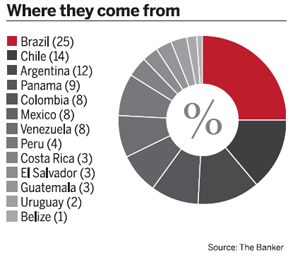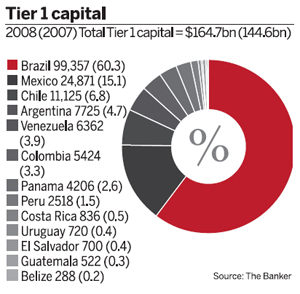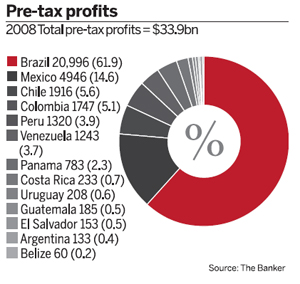Brazil maintains lead in LatAm listing
Although the pre-tax profits of Latin American banks have slipped, Tier 1 capital figures have grown by 14% and Brazil has firmly held onto its regional dominance. Writer Silvia Pavoni
Immunity from the global economic crash and financial markets collapse can not be granted to any region of the world, but some seem to have withstood the impact better than others. Latin America has been implementing tight fiscal policies and has built significant levels of international reserves as a result of higher commodity prices.
Furthermore, some of its local banking systems have matured over the past few years. Latin America's own crisis of the mid-1990s saw regulators taking bold steps and, as a result, they were prepared for the much more virulent global financial crash of last year.
It should not come as a surprise, then, that the region's Top 100 banks display reassuringly strong Tier 1 capital figures, up by nearly 14% to $164.7bn. However, profitability has inevitably slumped due to the world's economic troubles, with aggregate numbers at a lower $33.9bn in pre-tax profits, compared with the previous rankings' $43.55bn.
The geographical breakdown of the top lenders has not changed in the past few years and Brazil is still home to the largest banks in the region. Last year's leading bank, Banco Bradesco, however, has been pushed back into second position by the merger between Itau and Unibanco, previously the second and third highest lenders in the ranking. Bradesco's 25.2% increase in Tier 1 capital, to $21.47bn, just was not enough to compete with Itau-Unibanco's impressive $26bn figure.
The merger has created a bank with $357bn in assets and a total deposits base of 222.64bn reais ($111bn), according to the Brazilian central bank. The new group is not only the new leading Latin American lender, it is also the highest ranking for a Latin American bank in recent years, in 33rd place in The Banker's Top 1000 world banks listing. The deal is significant for the imposing size of the new player and gives the country, and the region, even higher expansion abilities.
It will be interesting to see how the recent Santander initial public offering, this year's largest, will affect next year's ranking. Santander merged its Brazilian operations with ABN Amro's Banco Real as park of the Dutch bank's break-up in 2007.
Mexican twist
One less Brazilian bank at the top of the ranking means a higher place is available for Mexico's Banamex, climbing up to fifth position with its $7.8bn in Tier 1 capital. In one of the twists of the financial crisis, the bank's owner, New York-based Citi, might be forced to sell its stake as Mexican laws prohibit foreign governments from having dominant interest in its banks, and after the US government's acquisition of a 34% stake in Citi, such laws could be applied to the Banamex case.
Chile and Argentina follow Brazil's lead for the highest number of banks in the ranking, with 14 and 12 banks, respectively. However, it is Mexico that hosts the strongest players after Brazil, firmly holding second position for combined Tier 1 capital ($24.87bn) and pre-tax profits ($4.95bn).
For details of the Top 100 Latin American Banks, please click here





